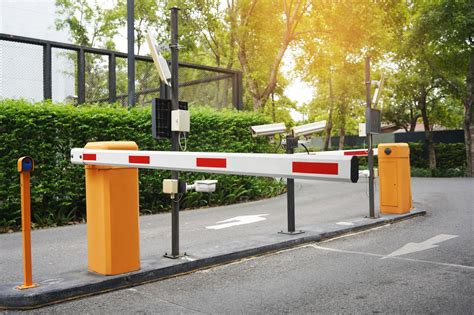How Do Car Park Barriers Work
Ronan Farrow
Apr 04, 2025 · 3 min read

Table of Contents
How Do Car Park Barriers Work? A Comprehensive Guide
Car park barriers are essential for managing access to parking areas, ensuring security, and optimizing space utilization. Understanding how these systems function is crucial for both property owners and users. This comprehensive guide delves into the mechanics, types, and benefits of car park barriers.
The Mechanics of a Car Park Barrier System
At its core, a car park barrier system consists of a few key components working in harmony:
1. The Barrier Arm:
This is the most visible part, a long, usually horizontally mounted arm that rises and falls to block or allow vehicle access. The arm itself can be made of various materials, including steel, aluminum, or even reinforced rubber for added safety. The weight and length of the arm depend on the specific application and the security level required.
2. The Drive Mechanism:
This is the "engine" of the system, responsible for raising and lowering the barrier arm. Common drive mechanisms include:
- Hydraulic Systems: These use hydraulic fluid pressure to power the arm's movement. They're known for their smooth operation and strong lifting power, ideal for heavier barrier arms.
- Electric Motors: Electric motors provide a cleaner, quieter, and often more energy-efficient alternative. These are increasingly popular due to advancements in motor technology.
- Electromagnetic Systems: These systems employ powerful electromagnets to lift and hold the barrier arm in place. They are often chosen for their compact size and quick operation.
3. The Control System:
This is the brain of the operation, managing the entire system. Control systems can vary in complexity:
- Simple Push-Button Controls: These are suitable for smaller parking areas with limited access needs.
- Loop Detectors: These sensors detect the presence of vehicles, automatically raising the barrier when a car approaches and lowering it after it passes. This ensures seamless and efficient traffic flow.
- Remote Controls: These allow authorized personnel to control the barrier remotely, offering flexibility and enhanced security.
- Integrated Access Control Systems: These sophisticated systems integrate the barrier with other security features like RFID readers, keypads, and license plate recognition technology, providing a highly secure and managed access solution.
4. Safety Features:
Modern car park barriers incorporate various safety features to protect both vehicles and people:
- Emergency Stop Buttons: These allow immediate halting of the barrier's operation in case of emergency.
- Obstacle Detection Sensors: These sensors detect any obstacles in the path of the lowering barrier, preventing accidents.
- Photocells: Similar to obstacle detection, photocells use light beams to detect objects in the barrier's path, automatically stopping the arm before impact.
- Slow-Lowering Mechanisms: These gradually lower the arm to reduce the risk of damage.
Types of Car Park Barriers
Car park barriers are available in a variety of configurations to suit different needs:
- Straight Barriers: The most common type, these offer straightforward access control.
- Folding Barriers: Ideal for space-saving applications, particularly in areas with limited space.
- Bollards: These are shorter, retractable posts primarily used for access control in pedestrian areas or for delineating specific zones.
- Rising Bollards: Similar to bollards but offering stronger security through rising mechanisms.
Benefits of Using Car Park Barriers
The implementation of car park barriers offers numerous advantages:
- Enhanced Security: Restricts unauthorized vehicle access, deterring theft and vandalism.
- Improved Traffic Management: Optimizes traffic flow and minimizes congestion.
- Space Optimization: Ensures efficient use of parking space, particularly in high-density areas.
- Revenue Generation: Facilitates pay-on-exit or pay-on-entry systems for revenue generation.
- Increased Safety: Minimizes accidents and collisions, improving overall safety.
Car park barriers are a crucial aspect of modern parking management. By understanding their operational principles, different types, and safety features, you can select the system best suited to your requirements, ensuring a secure and efficient parking experience.
Featured Posts
Also read the following articles
| Article Title | Date |
|---|---|
| How Do You Reset A Chrysler Pacifica Sliding Door | Apr 04, 2025 |
| How Does Santa Go Down The Chimney Book | Apr 04, 2025 |
| How Do Combi Weapons Work | Apr 04, 2025 |
| How Fast Does Periodontitis Progress | Apr 04, 2025 |
| How Do Vanlifers Make Money | Apr 04, 2025 |
Latest Posts
-
How Hard Is It To Get Into Ibew
Apr 04, 2025
-
How Hard Is It To Get Into Davidson Young Scholars
Apr 04, 2025
-
How Hard Is It To Get Into Chiropractic School
Apr 04, 2025
-
How Hard Is It To Catch A Bluefin Tuna
Apr 04, 2025
-
How Hard Is Dental Assisting
Apr 04, 2025
Thank you for visiting our website which covers about How Do Car Park Barriers Work . We hope the information provided has been useful to you. Feel free to contact us if you have any questions or need further assistance. See you next time and don't miss to bookmark.
